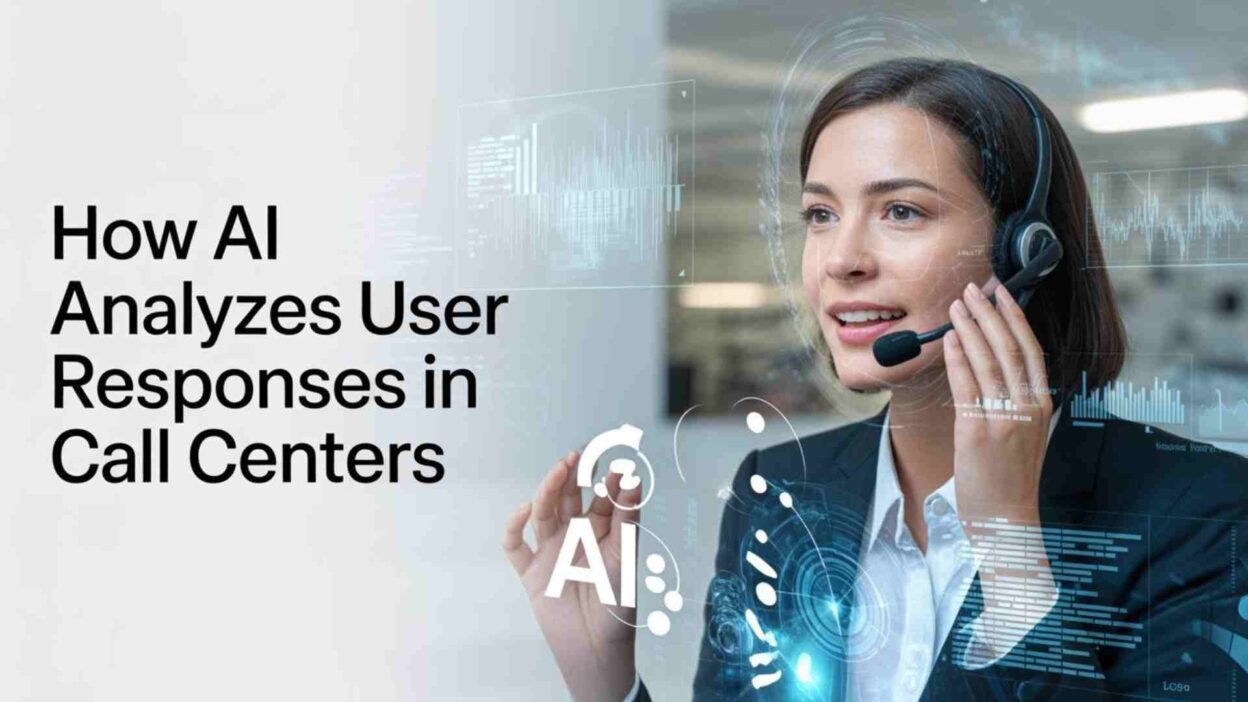TL;DR Call centers handle millions of customer interactions daily. Each conversation contains valuable insights about customer needs and preferences. Traditional methods struggle to capture and analyze this massive data volume.
Table of Contents
AI-powered customer response tracking transforms how businesses understand their customers. Machine learning algorithms process conversations in real-time. They extract meaningful patterns from voice and text interactions instantly.
Customer service teams gain unprecedented visibility into caller sentiments. AI systems detect frustration, satisfaction, and confusion automatically. Managers make informed decisions based on comprehensive interaction data.
Understanding AI Technology in Modern Call Centers
Call centers have evolved dramatically over the past decade. Basic phone systems gave way to sophisticated communication platforms. Customer expectations for service quality increased exponentially.
How AI analyzes user responses in call centers represents a technological breakthrough. Natural language processing decodes human speech patterns accurately. Sentiment analysis reveals emotional states during conversations.
AI systems operate continuously without fatigue or distraction. They monitor every call simultaneously across multiple channels. Human supervisors could never achieve this scale of coverage.
Machine learning models improve their accuracy with each interaction. They learn from millions of conversations across different scenarios. Performance enhances automatically without manual programming updates.
The Foundation of AI Response Analysis
Voice recognition technology converts speech into analyzable text. AI engines process this text for keywords and phrases. Semantic analysis understands context beyond individual words.
Neural networks identify patterns across thousands of similar conversations. They recognize when customers express specific needs or complaints. Classification algorithms categorize responses into actionable categories automatically.
Emotion detection algorithms analyze vocal tone and speech patterns. They measure stress levels, happiness, and frustration objectively. These insights help supervisors intervene when necessary.
Real-time processing enables immediate response adjustments during calls. Agents receive AI-generated suggestions while conversing with customers. Call outcomes improve through this intelligent assistance.
Key Components of AI Analysis Systems
Speech-to-text engines form the first layer of analysis. They transcribe conversations with remarkable accuracy rates. Modern systems handle various accents and speaking speeds effectively.
Natural language understanding interprets meaning from transcribed text. It identifies customer intent behind specific questions. The system distinguishes between literal words and actual needs.
Sentiment analysis engines evaluate emotional tone throughout conversations. They track sentiment shifts as calls progress. Negative sentiment triggers alerts to supervisors immediately.
Predictive analytics forecasts likely call outcomes based on patterns. They suggest optimal responses to guide agents successfully. Call resolution rates increase through these intelligent recommendations.
Speech Recognition and Natural Language Processing
Voice data presents unique analytical challenges for technology. Background noise complicates accurate transcription efforts. Multiple speakers talking simultaneously create additional difficulties.
Modern AI systems overcome these obstacles remarkably well. Deep learning models trained on millions of voice samples. They achieve accuracy rates exceeding human transcriptionists regularly.
AI-powered customer response tracking begins with precise speech recognition. Every word matters when analyzing customer satisfaction levels. Missing keywords could lead to incorrect sentiment assessments.
Advanced Voice Recognition Capabilities
AI distinguishes between different speakers during conference calls. It attributes statements to specific participants accurately. This capability proves essential for quality assurance reviews.
Accent adaptation algorithms adjust to regional speech patterns. Systems trained on diverse voice samples handle global customers. Recognition accuracy remains high regardless of caller origin.
Real-time transcription happens faster than actual conversation speed. AI processes speech within milliseconds of utterance. Agents access transcripts immediately for reference purposes.
Noise cancellation technology filters background sounds automatically. Coffee shop environments no longer compromise transcription quality. Home-based agents work effectively without soundproof booths.
Natural Language Understanding in Action
Understanding context separates advanced AI from basic keyword matching. Customers express identical needs using vastly different words. NLU algorithms recognize these semantic equivalents automatically.
Intent classification determines what customers actually want. Someone asking about “canceling service” requires different handling. The system routes calls based on detected intent.
Entity extraction identifies specific products, account numbers, and dates. AI pulls relevant information from conversational flow automatically. Agents spend less time asking customers to repeat details.
How AI analyzes user responses in call centers includes contextual memory. Systems remember earlier conversation portions during analysis. This continuity ensures accurate interpretation of references and pronouns.
Sentiment Analysis and Emotion Detection
Customer emotions drive satisfaction and loyalty significantly. Frustrated callers may leave competitors despite problem resolution. Happy customers become brand advocates who refer others.
AI detects emotional states with surprising accuracy. Voice analysis measures pitch, speed, and vocal tension. Text analysis evaluates word choices and punctuation patterns.
Sentiment scoring provides quantifiable emotional metrics for each interaction. Managers track sentiment trends across time periods. They identify systemic issues causing widespread customer frustration.
Real-Time Emotion Monitoring
AI monitors emotional states continuously throughout calls. It detects when customers become increasingly frustrated. Supervisors receive alerts before situations escalate uncontrollably.
Positive sentiment detection identifies successful agent behaviors. Managers recognize and reward effective communication techniques. Training programs incorporate these proven success patterns.
Emotional journey mapping visualizes sentiment changes during conversations. Peaks and valleys reveal which moments matter most. Companies optimize scripts based on these insights.
AI-powered customer response tracking captures subtle emotional nuances. Sarcasm detection prevents misclassification of negative comments. Context-aware analysis understands humor versus genuine complaints.
Predicting Customer Behavior from Sentiment
Churn prediction models analyze sentiment patterns over time. Consistently negative interactions signal high cancellation risk. Retention teams intervene proactively with at-risk customers.
Upsell opportunity identification spots satisfied customers open to suggestions. AI recommends optimal moments for product recommendations. Sales conversion rates improve through intelligent timing.
Net Promoter Score predictions emerge from sentiment analysis. AI estimates the likelihood that customers would recommend services. Companies gauge brand health without extensive surveys.
Intent Recognition and Response Categorization
Customers contact call centers for countless different reasons. Account inquiries, technical support, and billing questions require distinct handling. AI categorizes caller intent automatically within seconds.
Intent recognition accelerates call routing to appropriate specialists. Technical issues reach technical support directly. Billing questions connect with accounting experts immediately.
How AI analyzes user responses in call centers includes multi-intent detection. Single calls often involve multiple unrelated issues. AI tracks each intent separately for comprehensive analysis.
Classification Accuracy and Machine Learning
Training data quality determines classification system accuracy. AI learns from thousands of manually labeled conversations. Performance improves as training datasets expand continuously.
Multi-class classification handles numerous intent categories simultaneously. Systems distinguish between hundreds of possible customer needs. Accuracy rates exceed 90% in well-trained systems.
Confidence scoring indicates AI certainty about classifications. Low confidence triggers human review automatically. This hybrid approach maximizes both speed and accuracy.
Continuous learning updates models based on new interactions. AI adapts to emerging customer needs without manual retraining. Classification schemes evolve alongside business changes naturally.
Handling Complex and Ambiguous Queries
Customers rarely express needs in clear, structured language. Rambling explanations contain relevant information scattered throughout. AI extracts key points despite conversational disorganization.
Ambiguity resolution asks clarifying questions when intent remains unclear. Interactive systems narrow possibilities through targeted inquiries. Customers receive accurate assistance faster than human-only systems.
Multi-turn conversation analysis tracks intent across entire interactions. Initial questions may not reveal the actual underlying needs. AI connects dots across multiple conversation exchanges.
AI-powered customer response tracking identifies hidden issues customers don’t explicitly mention. Underlying frustrations surface through language pattern analysis. Agents address root causes rather than surface symptoms.
Pattern Recognition Across Customer Interactions
Individual conversations provide limited insights alone. Patterns emerge when analyzing thousands of interactions collectively. AI excels at discovering these large-scale trends.
Common complaint themes surface automatically without manual review. Product defects affecting many customers get identified quickly. Companies fix widespread issues before losing significant business.
Seasonal pattern detection reveals cyclical customer behavior changes. Holiday periods bring different question types than normal times. Staffing adjustments optimize for predictable demand variations.
Identifying Recurring Customer Pain Points
Frequency analysis counts how often specific issues appear. The most common problems receive priority attention. Resources focus on where they deliver maximum customer impact.
Correlation analysis links problems to specific products or services. Defective product batches trigger complaint spikes immediately. Quality control teams receive early warning alerts.
Resolution effectiveness tracking measures which solutions actually work. AI identifies which responses successfully address issues. Unsuccessful approaches get replaced with proven alternatives.
How AI analyzes user responses in call centers includes trend forecasting. Historical patterns predict future customer concern volumes. Call centers prepare staffing and resources accordingly.
Comparative Analysis Across Segments
Demographic segmentation reveals how different groups experience services. Age groups may encounter distinct challenge types. Personalized approaches improve satisfaction for each segment.
Geographic analysis identifies location-specific issues. Regional infrastructure problems affect local customer populations. Targeted solutions address area-specific concerns effectively.
Product line comparisons show which offerings generate the most support needs. High-maintenance products may require redesign or better documentation. Investment decisions benefit from usage pattern insights.
Quality Assurance and Agent Performance Monitoring
Call monitoring traditionally required supervisors to listen to random samples. This approach missed most interactions completely. Quality issues went undetected until customers complained publicly.
AI reviews 100% of customer interactions automatically. Every conversation receives consistent evaluation against quality standards. Performance gaps surface immediately rather than weeks later.
AI-powered customer response tracking provides objective performance measurements. Human bias disappears from quality assessments completely. Agents receive fair evaluations based on actual behaviors.
Automated Call Scoring and Evaluation
AI evaluates calls against customizable quality criteria instantly. Greeting quality, resolution effectiveness, and professionalism all get scored. Supervisors review only exceptions requiring human judgment.
Compliance monitoring ensures agents follow legal and regulatory requirements. Mandatory disclosures get verified automatically on every call. Companies avoid penalties from oversight failures.
Script adherence tracking measures whether agents follow approved processes. Deviations from best practices trigger coaching opportunities. Performance improves through targeted feedback delivery.
Soft skills assessment evaluates empathy, patience, and communication effectiveness. AI measures these traditionally subjective qualities objectively. Development plans address specific improvement areas precisely.
Coaching and Training Optimization
AI identifies specific skills each agent needs to develop. Generic training gives way to personalized learning plans. Development time focuses on areas needing improvement most.
Success pattern recognition discovers what top performers do differently. These techniques get shared across entire teams systematically. Average performers adopt proven success strategies quickly.
How AI analyzes user responses in call centers reveals training program effectiveness. Post-training performance improvements get measured quantitatively. Companies invest in programs delivering measurable results.
Real-time coaching prompts guide agents during challenging situations. AI suggests responses when difficult questions arise. New agents perform like veterans with intelligent assistance.
Customer Journey Mapping and Experience Optimization
Single interactions represent mere snapshots of customer relationships. Complete journeys involve multiple touchpoints across various channels. Understanding these journeys requires connecting fragmented data pieces.
AI links interactions across phone, email, chat, and social media. Complete customer timelines emerge from disparate data sources. Journey visualization reveals friction points causing dissatisfaction.
Critical moment identification pinpoints interactions determining overall satisfaction. Single negative experiences can overshadow many positive ones. Companies prioritize fixing these high-impact moments.
Cross-Channel Integration and Analysis
Omnichannel customers interact through their preferred communication methods. AI consolidates interactions regardless of the channel used. Holistic views replace siloed channel-specific perspectives.
Channel preference analysis shows which communication methods customers favor. Demographic patterns influence channel selection significantly. Companies optimize availability across preferred channels.
Consistency measurement evaluates whether customers receive uniform experiences. Contradictory information across channels destroys trust quickly. AI identifies these dangerous inconsistencies automatically.
AI-powered customer response tracking creates unified customer profiles. Every interaction adds knowledge to accumulated histories. Agents access the complete context during every conversation.
Predictive Experience Modeling
Future interaction prediction anticipates customer needs proactively. Someone calling about billing likely wants recent charge explanations. Systems prepare relevant information before customers ask.
Proactive outreach opportunities emerge from journey analysis. Customers showing early frustration signs receive preemptive assistance. Problems get resolved before escalating into complaints.
Experience optimization recommendations suggest specific improvement actions. Data-driven insights replace guesswork about customer preferences. Resources focus on changes delivering measurable satisfaction gains.
Real-Time Response Guidance for Agents
Agents face enormous pressure during customer interactions. They must process information quickly while maintaining professionalism. Split-second decisions impact customer satisfaction significantly.
AI provides intelligent assistance without replacing human judgment. Real-time suggestions appear on agent screens automatically. Recommended responses accelerate problem resolution dramatically.
How AI analyzes user responses in call centers powers these guidance systems. Analysis happens simultaneously with ongoing conversations. Agents receive help exactly when needed most.
Dynamic Script Adjustment
Static scripts fail to accommodate conversation unpredictability. Customers take unexpected conversational directions frequently. AI adapts guidance based on actual conversation flow.
Next-best-action recommendations suggest optimal responses for current situations. Multiple conversation paths remain available simultaneously. Agents choose approaches fitting specific customer personalities.
Knowledge base integration surfaces relevant information automatically. Agents no longer search databases while customers wait. Answers appear instantly based on question understanding.
Personalization engines customize responses using customer history. Loyal customers receive different treatment from first-time callers. Relationship-appropriate interactions strengthen customer bonds.
Escalation Prevention and Management
Early warning systems detect conversations heading toward escalation. Supervisor intervention happens before customers demand managers. Many situations resolve without escalation entirely.
De-escalation technique suggestions help agents calm frustrated customers. AI recommends empathy statements and solution-focused responses. Training reinforcement happens during actual customer interactions.
AI-powered customer response tracking measures escalation trigger patterns. Common themes causing customer anger get identified clearly. Process improvements address root causes systematically.
Compliance and Risk Management
Regulated industries face strict communication requirements. Financial services, healthcare, and insurance must follow numerous rules. Compliance violations result in substantial penalties and reputational damage.
AI monitors every conversation for regulatory compliance automatically. Required disclosures get verified instantly during calls. Supervisors receive alerts about potential violations immediately.
Legal risk reduction happens through comprehensive conversation documentation. Audio recordings pair with accurate transcripts and analysis. Complete records prove compliance during audits or disputes.
Automated Compliance Verification
Mandatory statement detection confirms agents deliver required disclosures. Recording permission, privacy notices, and legal warnings get tracked. Documentation proves compliance with industry regulations.
Prohibited language identification prevents agents from making illegal statements. Guarantee claims, medical advice, and unauthorized promises trigger alerts. Real-time corrections prevent costly compliance breaches.
Sensitive information handling verification ensures proper data protection. Credit card numbers and health information require specific protocols. AI confirms agents follow security procedures correctly.
How AI analyzes user responses in call centers includes regulatory reporting. Compliance summaries compile automatically for audit purposes. Manual report preparation becomes unnecessary.
Fraud Detection and Security
Voice biometrics verify caller identities without security questions. Unique vocal characteristics authenticate customers seamlessly. Fraudsters find impersonation virtually impossible.
Suspicious behavior pattern recognition identifies potential fraud attempts. Unusual question patterns trigger additional verification steps. Security breaches get prevented before damage occurs.
Social engineering attempt detection spots manipulation tactics. Fraudsters using psychological tricks get flagged automatically. Agents receive warnings about suspicious caller behaviors.
Data Analytics and Business Intelligence
Call center interactions generate enormous data volumes. Raw conversation recordings provide limited business value alone. Analysis transforms this data into actionable intelligence.
Trend identification reveals changing customer needs over time. New product features generate support requests predictably. Development teams receive customer feedback automatically.
AI-powered customer response tracking powers executive dashboards. Leadership teams access real-time customer sentiment metrics. Strategic decisions incorporate actual customer voice insights.
Performance Metrics and KPIs
First call resolution rates measure problem-solving effectiveness. AI tracks which issues get resolved during initial contacts. Training focuses on scenarios requiring multiple interactions.
Average handle time optimization balances efficiency with quality. AI identifies unnecessary conversation segments consuming time. Processes streamline without sacrificing customer satisfaction.
Customer satisfaction score predictions emerge from interaction analysis. AI estimates satisfaction without waiting for survey responses. Real-time metrics enable immediate corrective actions.
Net Promoter Score correlation links specific behaviors to loyalty. Agents learn which actions create promoters versus detractors. Coaching emphasizes high-impact satisfaction drivers.
Competitive Intelligence Gathering
Customer comparisons to competitors surface organically during calls. AI captures these mentions automatically for analysis. Companies understand their competitive positioning accurately.
Feature request tracking identifies desired product improvements. Customer suggestions guide development roadmap priorities. Products evolve based on actual user needs.
Market trend detection spots emerging customer preferences early. Companies adapt their offerings before competitors recognize changes. Strategic advantages emerge from customer conversation insights.
Integration with CRM and Business Systems
Call center data provides maximum value when connected to broader systems. Customer relationship management platforms need interaction insights. How AI analyzes user responses in call centers feeds enterprise systems automatically.
Automated data synchronization eliminates manual entry requirements. Interaction summaries flow to CRM records instantly. Sales and support teams access complete customer histories.
Seamless Information Flow
API connections link AI analysis systems with existing platforms. Real-time data exchange happens without human intervention. Information silos disappear through intelligent integration.
Customer profile enrichment adds interaction insights to existing records. Preferences, complaints, and feedback accumulate systematically. Relationship understanding deepens with each conversation.
Workflow automation triggers actions based on interaction analysis. Support tickets generate automatically for unresolved issues. Follow-up tasks appear on appropriate team member calendars.
AI-powered customer response tracking enhances marketing campaign effectiveness. Conversation insights inform messaging and targeting strategies. Customer communications resonate more effectively.
Implementation Challenges and Best Practices
Deploying AI in call centers requires careful planning. Legacy infrastructure may not support advanced analytics. Data quality issues compromise analysis accuracy significantly.
Change management proves critical for successful adoption. Agents may fear AI replacing their jobs. Clear communication about AI augmentation versus replacement matters enormously.
Technical Infrastructure Requirements
Cloud-based platforms provide scalability and flexibility advantages. On-premise deployments offer greater data control. Architecture decisions depend on security and compliance needs.
Data pipeline construction connects multiple systems seamlessly. Clean data flows through processing stages systematically. Quality controls prevent garbage-in-garbage-out problems.
Processing power requirements scale with interaction volumes. High-traffic call centers need substantial computational resources. Infrastructure investments must match analysis ambitions.
Security measures protect sensitive customer conversation data. Encryption, access controls, and audit trails prevent breaches. Compliance requirements dictate specific security implementations.
Organizational Change Management
Stakeholder buy-in begins with demonstrating clear value propositions. Pilot programs prove AI effectiveness before full deployment. Success stories overcome skepticism effectively.
Agent training programs explain AI capabilities and limitations. Employees learn to work alongside intelligent systems. Fear transforms into appreciation for helpful assistance.
How AI analyzes user responses in call centers requires ongoing refinement. Initial deployments reveal unexpected challenges regularly. Continuous improvement processes address issues systematically.
Future Trends in AI Call Center Analytics
Technology advancement continues accelerating rapidly. Emerging capabilities will transform call centers further. Early adopters gain significant competitive advantages.
Emotion AI will detect increasingly subtle sentiment nuances. Stress, confusion, and delight recognition improves continuously. Customer emotional intelligence reaches human-expert levels.
Predictive capabilities will forecast customer needs before contact. Proactive outreach prevents problems rather than reacting. Customer service becomes truly anticipatory.
Emerging Technologies and Capabilities
Conversational AI will handle routine inquiries autonomously. Human agents focus on complex situations requiring judgment. Efficiency and quality improve simultaneously.
Multilingual analysis will break language barriers completely. Real-time translation enables global customer support. Geographic location becomes irrelevant for service delivery.
Biometric integration will enhance security and personalization. Voice, face, and behavioral patterns authenticate seamlessly. Fraud prevention strengthens while convenience improves.
Augmented reality will guide agents through technical support. Visual AI assists with troubleshooting complex problems. First-call resolution rates increase dramatically.
Frequently Asked Questions
How accurate is AI at analyzing customer responses?
Modern AI systems achieve 85-95% accuracy in sentiment analysis. Speech recognition accuracy exceeds 95% in optimal conditions. Continuous learning improves performance over time steadily.
Can AI replace human call center agents completely?
AI augments rather than replaces human agents currently. Complex situations requiring empathy need human handling. Technology handles routine tasks while humans manage exceptions.
What data does AI need to analyze responses effectively?
AI-powered customer response tracking requires conversation audio or transcripts. Historical interaction data improves analysis accuracy significantly. Customer profile information enhances personalization capabilities.
How does AI handle different accents and languages?
Advanced systems train on diverse voice samples globally. Accent adaptation algorithms adjust to regional variations. Multilingual models process numerous languages simultaneously.
What privacy concerns exist with AI call analysis?
Data encryption protects sensitive customer information. Access controls limit who views conversation analyses. Compliance frameworks address privacy regulations comprehensively.
How long does AI implementation take for call centers?
Basic implementations complete within three to six months. Comprehensive deployments require one to two years. Phased rollouts minimize disruption during transitions.
What ROI can companies expect from AI analytics?
Cost reductions of 20-40% occur through efficiency gains. Customer satisfaction improvements average 15-25%. Revenue increases emerge from better customer retention.
Does AI work for small call centers?
Cloud-based solutions make AI accessible to operations of all sizes. Subscription models eliminate large upfront investments. How AI analyzes user responses in call centers scales appropriately.
Read More: The Role of Municipalities in Building Utility Networks
Conclusion

Call centers generate massive amounts of valuable customer data. Traditional analysis methods capture only tiny fractions. AI-powered customer response tracking unlocks complete conversation intelligence.
Machine learning algorithms process every interaction comprehensively. They extract insights humans would miss entirely. Customer understanding reaches unprecedented depth and accuracy.
Speech recognition converts voice conversations into analyzable text. Natural language processing interprets meaning beyond individual words. Sentiment analysis reveals emotional states throughout interactions.
Intent recognition categorizes customer needs automatically and instantly. Pattern analysis discovers trends across thousands of conversations. Quality monitoring ensures consistent service excellence.
Real-time guidance helps agents deliver superior customer experiences. Predictive analytics anticipate needs before customers articulate them. Proactive service replaces reactive problem-solving approaches.
Compliance monitoring protects companies from regulatory violations. Fraud detection prevents security breaches automatically. Risk management improves dramatically through comprehensive oversight.
The combination of human empathy and machine intelligence delivers optimal results. Agents focus on relationship building and complex problem-solving. AI handles data analysis and routine task automation.
Customer satisfaction improves measurably through intelligent assistance. First-call resolution rates increase significantly. Handle times decrease without sacrificing service quality.
The future belongs to organizations leveraging AI effectively. How AI analyzes user responses in call centers will only become more sophisticated. Those embracing change today will lead their industries tomorrow.


